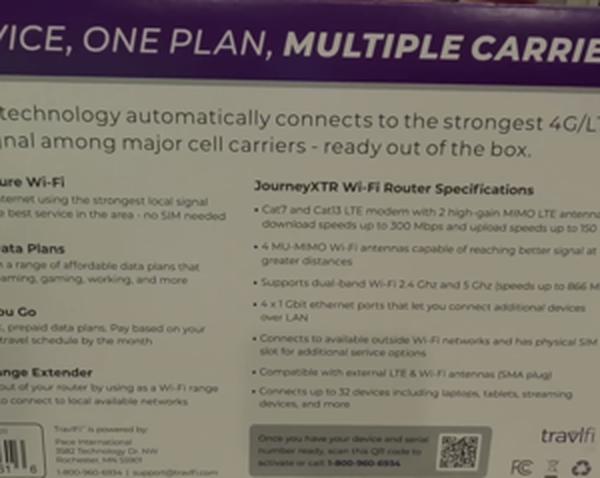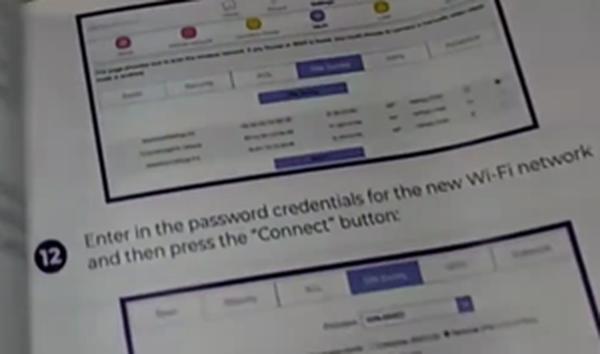
Using the TravlFi JourneyXTR Portable Wi-Fi Router (2024)
My thoughts on TravlFi JourneyXTR: coverage, plans, performance, customer service.
Introduction
I recently used the TravlFi JourneyXTR for my travels and work requirements. As a frequent traveler, I've been searching for a dependable internet solution on-the-go. I put this device through various tests to determine if it delivers on its claims.
Some photos (click to enlarge)




Specs of the TravlFi JourneyXTR Wi-Fi Router
- Release Year
- Brand
- Compatible Devices
- Connectivity Technology
- Frequency
- Frequency Band Class
- Model Name
- Recommended Uses For Product
- Special Feature
- Wireless Communication Standard
- Routers-included-components
Prices
Connectivity and Coverage

When evaluating the TravlFi JourneyXTR for connectivity and coverage, I immediately noticed several commendable points:
Extensive Coverage: Boasting almost nationwide coverage within the U.S., I didn't have to worry about losing connection, regardless of where I traveled. This is a significant advantage when working remotely or enjoying leisure activities without fixed internet access.
Dynamic Signal Optimization: The ability for the device to automatically seek out and connect to the strongest cellular signal is impressive. It brings peace of mind knowing that whether I'm stationary or on the move, my internet connection is being actively managed for the best performance.
However, it's not all smooth sailing. There are a couple of drawbacks worth mentioning:
Occasionally, I found my smartphone had better reception compared to the router, which suggests that the JourneyXTR might not always be the most sensitive in picking up weak signals. This might not be a deal-breaker for everyone but it's something to consider in truly remote areas.
Network Priority Issues: Since TravlFi is a third-party reseller, it seems that their devices might not be prioritized on the networks. This can result in slower speeds, especially during peak times when the network is congested.
From a technical standpoint, the TravlFi JourneyXTR did what it promised. It facilitated a secure connection through E-SIM technology, avoiding the need for public Wi-Fi. What I found most beneficial was the convenience it offered — a pay-as-you-go service without long-term commitments.
As a digital nomad, coverage is crucial. While it does well in urban and suburban areas, be cautious when venturing into more remote locations. If your work requires constant, high-speed internet, this might be a point to seriously consider.
Nevertheless, the JourneyXTR is still a compelling option for those of us who value mobility and ease of use. It's clear that while it has a few caveats, the positives — notably its extensive coverage and dynamic signal optimization — are strong selling points for anyone who needs a reliable internet connection on the move.
Data Plans and Flexibility

The flexibility of data plans from TravlFi with their JourneyXTR router has been a significant advantage for people like me who travel frequently and rely on stable internet connectivity. Here's what I've found:
No Contract: It's refreshing not to be tied down by long-term commitments, and being able to pay for data as I need it on a monthly basis is ideal for my varying travel schedule.
Range of Data Plans: Options range from a minimal 2GB to an unlimited plan. Although, it's important to note that the unlimited plan comes with a caveat: speeds may be reduced after substantial usage, which seems to be a threshold of 800GB.
E-SIM Technology: The hassle of switching physical SIM cards is eliminated, providing seamless transitions between service providers.
Despite the positives, the JourneyXTR isn't without its potential hiccups. The performance can be inconsistent in remote areas, and in times of high network congestion, speeds suffer, mirroring problems any cell phone user might face. Yet, it's a game-changer when it can connect to the strongest signal without any manual interference, especially when moving from place to place.
One other observation I've had: my phone, at times, seems to have a stronger signal than the router. This may point to issues with the JourneyXTR's sensitivity or perhaps the carriers' prioritization of direct subscribers over third-party services.
In areas with busy towers, patience is key, as performance can be hit-or-miss. While it's excellent during off-peak times, those requiring constant, high-speed connectivity may find this frustrates their needs.
Upon reflection, the TravlFi JourneyXTR suits a traveler like myself who appreciates the flexibility and "turn-off-and-on" nature of the service without long-term commitments. True, it might not be the robust enterprise-level solution that remote work in isolated locations demands, but it's a substantial improvement from what I've previously experienced. For moderate use, streaming, and standard browsing needs, it's proven reliable enough.
However, if your profession revolves around constant high-speed internet or if you're venturing into the often unchartered territory of the 'digital nomad' in truly remote landscapes, the limitations become apparent, and alternatives (potentially more expensive satellite setups) may be necessary.
All in all, the offering from TravlFi with the JourneyXTR strikes a neat balance, particularly for the RV consumer who values flexibility and simplicity over flawless performance in every situation. It's not a one-size-fits-all solution, but for the right user – it fits just fine.
Technology and Performance

When it comes to staying connected while on the move, technologies like the TravlFi JourneyXTR aim to ease the challenge. Based on my experience, this device stands out in several key areas.
Firstly, the integrated e-SIM technology ensures that there's no fiddling with physical SIMs while switching data plans or providers.
Secondly, it boasts a robust build quality, with a solid, trustworthy feel to the hardware.
Thirdly, the extender functionality is a significant advantage, seamlessly allowing the device to latch onto home networks and extend them, providing valuable continuity of service.
But it's not all perfect. Data speeds can fluctuate, and while I've generally found connectivity to be reliable, I've noticed my phone sometimes offers faster internet. This can be a bit frustrating, especially when the need for speed is paramount. Additionally, while the concept of switching among the major carriers is promising, the reality can be hit or miss, with certain areas seeing less than optimal performance.
The TravlFi JourneyXTR's user interface is approachable for beginners, though a lack of detailed guidance can leave users desiring more in-depth instructional resources. Technical support, though, has proved to be a valuable companion, offering necessary clarification and assistance when needed.
Let's explore some key elements of the technology and performance:
Setup: I found the configuration process straightforward, and even with the limited documentation, the main functions were relatively plug-and-play.
In-Motion Connectivity: This feature is hit-or-miss. However, when it works, it's a game-changer, offering internet access while traveling that’s consistent and serviceable.
Signal Optimization: The patented technology that scans for the best local cellular signal truly shines in suburban and urban environments, ensuring stable connections.
In remote areas, despite all the antennas and technology, performance can be less impressive—something prospective buyers should keep in mind. A satellite setup might be more appropriate for those regularly off the beaten path.
Ultimately, the JourneyXTR is a potent tool in an RV owner's arsenal, particularly for casual use and occasional remote work. While the occasional lag and signal search process may be a setback, these are balanced by the device's ease of use and the value of its service plans. My opinion leans positively, given the freedom and flexibility it offers—crucial for my roving lifestyle. However, it's important to weigh the occasional connectivity constraints against the overall convenience provided.
Customer Service Experience

In my experiences dealing with customer service across various products, I’ve learned that a responsive and knowledgeable support team can make or break the user experience. For TravIiFi JourneyXTR, I've had a fairly positive experience, though some aspects left room for improvement.
Here's a quick rundown of the customer support aspects based on my personal use:
Responsiveness: I found their customer service to be prompt when addressing my questions and issues. They usually picked up the call quickly or responded to my emails in a timely manner.
Knowledgeability: The support staff was generally well-informed about their product. They could provide detailed technical assistance, which I appreciated.
Issue Resolution: For the most part, my issues were resolved satisfactorily; however, there were times when I felt stuck, especially when dealing with signal discrepancies.
One of the drawbacks was the lack of extensive online resources which could have saved me time contacting customer service. I would appreciate more comprehensive user guides or tutorials, particularly in video format.
That being said, my positive interactions with customer service have instilled confidence in the product. Whenever I raised concerns about internet speed or connectivity issues, they were eager to assist and provided clear, step-by-step guidance on optimizing the device's performance. They managed to explain technical details in layman's terms, ensuring I could follow along easily—a crucial aspect for users who may not be as tech-savvy.
On the occasions when my TravlFi JourneyXTR didn't connect or delivered lower speeds than expected, customer support was my go-to. The guidance I received was spot-on, and they even advised on how to adjust the settings to improve connection stability. Furthermore, their patience with my numerous questions regarding data plan changes was commendable.
However, when the device experienced trouble finding a strong signal, customer support admitted the product's limitations, explaining that some remote areas might not offer optimal performance. While this honesty was appreciated, I couldn’t help but wish for a more robust solution to ensure uninterrupted service.
Dealing with customer service is an aspect many users dread, but with TravlFi, the experience was more reassuring than frustrating. Even when faced with service limitations, the support team’s willingness to help and provide clear information made a considerable difference. Still, I would advise potential buyers to consider the possibility of occasional hiccups that may require troubleshooting with customer service support.
In conclusion, the customer service at TravlFi has generally risen to the occasion, albeit with a few minor hitches regarding resource availability and signal limitations in certain areas. The customer service team’s competence and courtesy make it a product I'm comfortable sticking with for my on-the-go connectivity needs.
Comments (0)
Share